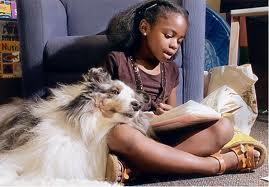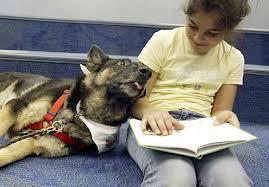 Maya’s got a pretty cushy job.
Maya’s got a pretty cushy job.
As she relaxes on a felt blanket in a corner classroom at Achievement First Bridgeport Academy in Connecticut, Maya listens to Hector Rivera sound out a short chapter book.
Hector, 6, has an index finger under the words he is sounding out as his other hand rests against Maya’s black fur coat.
Maya’s trainer, Avis Levine, resists the urge to correct any mistakes Hector makes as he plows through the first book, then a second, then a third in the span of 10 minutes.
At the end, the first-grader collects a dog sticker and a heartfelt “Good job!” from Levine before it is Tairae Harrell’s turn to read to Maya.
“It helps the dog learn,” Tairae suggested after he finished a short chapter book on raccoons. Asked if he likes to read, Tairae thinks for a moment before he finally responds, “Sometimes.”
The staff at Achievement First hopes Maya will change that.
“It is a snippet of time, but you can reference it all week,” said Katherine Baker, principal of the charter school that this year extends to the second grade. The school will eventually include the third and fourth grades.
Achievement First has been inviting Maya and Levine to the school once a week on Monday afternoons for the last 10 weeks to work with “reluctant readers.”
The Bridgeport school is believed to be the only school in Achievement First’s network of 22 schools using a Reading Education Assistance Dog. These dogs are trained to sit passively while children read to them.
The READ therapy dog concept has been around for more than a decade. Nursing homes use them. Both Fairfield University and Sacred Heart University in Fairfield had READ dogs on hand during finals week to help students relax.

At home, Maya has a really loud bark. The kids at Achievement First have never heard it.
“She knows she is not supposed to bark when she is working,” Levine said.
Maya isn’t as listless as she acts either, Levine said.
“I think she acts like she is sleeping. She is trying to decide how active she can be when she is being read to. She doesn’t want to be distracting to the child,” Levine said.
Baker said students like it when Maya falls asleep.
“Sometimes, they forget she is even there,” Baker said.
Students selected for the READ program don’t usually like to read in front of other children. Most are stuck and can’t move forward in their reading. There is an anxiety factor that Maya helps to break.
“We want every student in the school to have a reason to be really excited about reading,” said Heather Wachter, academic dean at the school.
“For some students, Maya helps those students find that spark and self-confidence …. It helps them get it unstuck and move past those reading levels that had been a plateau.”
The focus is on first grade because the best predictor of success in school is how well you read in lower elementary grades, Baker said, adding that most first-graders who fall behind in reading never catch up.
Students at the school are expected to read a tremendous amount. That’s hard to do if they don’t enjoy it, Wachter said.
Since the program started at Achievement First, seven of the eight students who have read with Maya have been able to move onto the next reading level.
Two children have made almost a year of progress in half a year, Wachter said.
Baker said it’s not just reading 10 minutes on a Monday with Maya that does the trick.
“It is a change in habits,” Baker said. “Reading is less scary. Maya is the impetus for that feeling.
“On a Wednesday, they can pick out a book they want to read to Maya and practice to get it right. Time with Maya is one piece of the puzzle.”
~ Courtesy of CTpost
Tags: children read to dog, dog assistance
